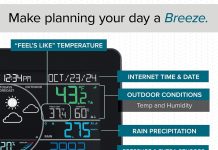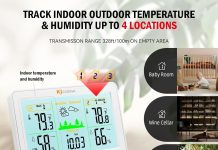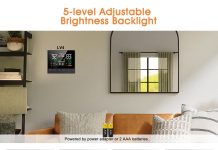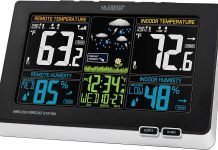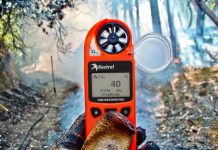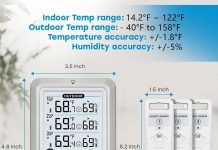Ladies and gentlemen, when it comes to measuring the ever-changing weather patterns in our surroundings, we often rely on professional meteorologists and their sophisticated equipment. But have you ever wondered whether a home weather station, perched in our own backyards, can accurately measure something as delicate and elusive as snowfall? Today, we embark on a captivating journey to uncover the truth behind this intriguing question. Brace yourselves, as we delve into the world of home weather stations and their ability to capture the beauty of snowflakes.
Review contents
How do home weather stations work?
Home weather stations are devices that allow individuals to monitor and measure various weather variables in their own backyard. These stations typically consist of sensors that are capable of detecting changes in temperature, humidity, wind speed and direction, barometric pressure, and precipitation. The sensors used in home weather stations are designed to be accurate and reliable, making it possible for users to obtain real-time weather data specific to their location.
Sensors used in home weather stations
Home weather stations incorporate a variety of sensors to measure different weather parameters. Temperature and humidity sensors are used to measure the air temperature and humidity levels in the surrounding environment. These sensors are usually located in a protective enclosure to ensure accurate readings.
Wind sensors, such as anemometers, are used to measure the speed and direction of the wind. These sensors often feature rotating cups or blades that spin in response to the wind, providing measurements that can be displayed in real-time.
Precipitation sensors are essential for measuring rainfall and snowfall. They work by detecting the presence of moisture and estimating the amount of precipitation. Some models utilize a tipping bucket mechanism that measures the volume of liquid precipitation, while others use a weighing mechanism to measure the weight of the snowfall.
Data collection and transmission
Once the sensors collect the weather data, it is processed and converted into digital signals. This data is then transmitted to a receiver or a display unit that is typically located indoors. In some cases, home weather stations may be connected to a console or a computer via a wired or wireless connection, allowing users to access the data remotely.
Some advanced home weather stations even offer internet connectivity, enabling users to upload their weather data to online platforms or weather networks. This not only allows users to easily access their weather data from different devices but also contributes to a larger network of weather enthusiasts and meteorologists who can analyze the data for a more comprehensive understanding of weather patterns.
Benefits of home weather stations
Having a home weather station offers numerous benefits to individuals and communities. By monitoring the weather conditions in their immediate vicinity, users can gain a better understanding of their local microclimate and make informed decisions regarding outdoor activities, gardening, and even home energy management.
Home weather stations also provide valuable data for amateur weather enthusiasts and citizen scientists, contributing to the overall understanding of weather patterns and climate change. Additionally, they can offer personalized weather forecasts specific to the user’s location, making it easier to plan activities and stay prepared for any potential weather events.
What is snowfall and how is it measured?
Snowfall refers to the process of snowflakes falling from the atmosphere and accumulating on the ground. It is an important weather variable, particularly in regions where snow is a regular occurrence during the winter months. Measuring snowfall accurately is crucial for various purposes, including forecasting, studying climate change, and determining the impact of snow on transportation and infrastructure.
Understanding the formation of snowflakes
Snowflakes form when water vapor in the atmosphere freezes into ice crystals. These ice crystals then grow in complexity as they pass through layers of moisture and freezing temperatures in the atmosphere. The unique six-sided structure of snowflakes is a result of their growth process.
Measuring snowfall using traditional methods
Traditionally, snowfall has been measured using a device called a snow gauge. Snow gauges are usually cylindrical containers with a wide opening at the top and a narrow opening at the bottom. The gauge is carefully placed in an open area where it can collect and measure snowfall.
To measure snowfall, the gauge is checked at regular intervals, and the snow depth is recorded by taking the difference between the current snow level and the level at the previous measurement. This method provides a manual measurement of snow depth, but it does not account for factors such as compaction, drifting, and sublimation that can affect the actual amount of snowfall.
Limitations of traditional snowfall measurement
Traditional methods of snowfall measurement using snow gauges have several limitations. Firstly, they rely on manual measurements, which are subject to human error and inconsistencies. Additionally, the location and placement of the snow gauge can significantly impact the accuracy of the measurements. In areas with strong winds or drifting snow, the gauge may not capture an accurate representation of the actual snowfall.
Furthermore, traditional snow gauges may struggle to accurately measure snowfall during extreme weather conditions, such as blizzards or heavy snowfall events. The buildup of snow on the gauge can obstruct the opening, leading to underestimation or the inability to measure snowfall altogether.
Can home weather stations accurately measure snowfall?
Yes, home weather stations can accurately measure snowfall with the right combination of sensors and proper placement. Home weather stations that incorporate precipitation sensors specifically designed for measuring snowfall can provide reliable and accurate data regarding snow depth and accumulation.
Snowfall measurement capabilities of home weather stations
Home weather stations with snowfall measurement capabilities utilize sensors that are sensitive to changes in precipitation type, such as rain or snow. These sensors can distinguish between liquid and solid precipitation and provide accurate measurements of snow depth. Some models even have the ability to measure the water equivalent of the snow, which is important for understanding the impact of snowfall on water resources.
Factors that affect accuracy
While home weather stations can accurately measure snowfall, certain factors can affect the accuracy of the measurements. The location and placement of the weather station are crucial. It is important to ensure that the sensors are not obstructed by nearby structures or vegetation, as this can interfere with the measurements.
Additionally, the calibration of the precipitation sensors is vital to ensure accurate readings. Regular maintenance and calibration of the weather station are necessary to account for any changes or drift that may occur over time.
Comparison with professional weather stations
Professional weather stations typically have more sophisticated and specialized equipment for measuring weather variables, including snowfall. These stations often have a higher accuracy and precision in their measurements due to their advanced technology and extensive calibration processes.
However, home weather stations can still provide valuable and reliable data for personal use and citizen science purposes. They offer a more affordable and accessible option for individuals and communities to monitor and measure snowfall in their immediate surroundings.
Features to consider in home weather stations for snowfall measurement
When choosing a home weather station for snowfall measurement, there are several important features to consider:
Temperature and humidity sensors
Accurate temperature and humidity sensors are essential for understanding the conditions that contribute to snowfall. Look for weather stations that have high-quality sensors capable of providing reliable measurements.
Wind sensors
Wind sensors are crucial for determining the wind speed and direction, which can affect the distribution and accumulation of snowfall. Ensure that the weather station includes a wind sensor, such as an anemometer, to capture this important data.
Precipitation sensors
Home weather stations with precipitation sensors specifically designed for snowfall measurement are ideal. These sensors should be capable of distinguishing between rain and snow and accurately measuring the snow depth.
Snow depth measurement capabilities
Some advanced home weather stations offer specialized sensors or attachments for directly measuring the snow depth. These sensors can provide more accurate and precise measurements of the snow accumulation.
Software and data analysis tools
Consider weather stations that come with software or data analysis tools that allow for easy visualization and analysis of the collected weather data. These features can enhance the overall usability and functionality of the weather station.
Installation and placement considerations for accurate snowfall measurement
Proper installation and placement of home weather stations are crucial for obtaining accurate snowfall measurements. Consider the following factors:
Choosing a suitable location
Select an open area that is representative of the surrounding environment. Avoid placing the weather station too close to structures or trees, as these can obstruct the sensors and affect the measurements.
Avoiding obstructions
Ensure that there are no obstructions in the immediate vicinity of the weather station that could interfere with the wind flow or cause drifting of snow. This will help capture accurate readings of wind speed and snow accumulation.
Proper mounting and alignment
Follow the manufacturer’s guidelines for mounting and aligning the weather station. Proper alignment ensures accurate readings from the wind and precipitation sensors. Avoid installing the station in areas with excessive vibrations or movements that could affect the measurements.
Maintenance and calibration
Regular maintenance is important to keep the weather station in optimal working condition. Clean the sensors and check for any signs of damage or deterioration. Calibration may be required periodically to ensure accurate measurements, particularly for the precipitation sensors.
What are the benefits of using home weather stations for measuring snowfall?
Using home weather stations for measuring snowfall offers numerous benefits:
Real-time monitoring and data accessibility
Home weather stations provide real-time data that can be accessed directly from the comfort of your own home. This allows for immediate awareness of the current weather conditions, including snowfall, making it easier to plan and adjust outdoor activities accordingly.
Personalized weather forecasts
With a home weather station, you can receive personalized weather forecasts specific to your location. This information can help you make informed decisions regarding travel, outdoor activities, and winter preparations.
Contribution to citizen science
By using a home weather station, you can contribute valuable data to citizen science projects and weather networks. This data is used by meteorologists and researchers to study weather patterns and climate change on a larger scale.
Tracking snowfall patterns and climate change
Long-term data collected by home weather stations can help track snowfall patterns over several seasons and contribute to our understanding of climate change. By monitoring and analyzing snowfall trends, we can identify any potential shifts in weather patterns.
Popular home weather station options for snowfall measurement
Several home weather station options are available that are suitable for measuring snowfall. Here are some popular choices:
AcuRite 01024M Pro Weather Station
The AcuRite 01024M Pro Weather Station offers a range of sensors for measuring temperature, humidity, wind speed and direction, and precipitation. It includes a self-emptying rain gauge that can accurately measure rainfall and snowfall.
Davis Instruments Vantage Pro2
The Davis Instruments Vantage Pro2 is a professional-grade weather station that provides accurate measurements of temperature, humidity, wind speed, and precipitation. It offers additional snowfall and snow depth measurement capabilities, making it a comprehensive option.
Ambient Weather WS-2902C
The Ambient Weather WS-2902C is a wireless weather station that measures temperature, humidity, wind speed and direction, and precipitation, including snowfall. It features a user-friendly interface and can be connected to online platforms for data analysis and sharing.
Netatmo Weather Station
The Netatmo Weather Station is a compact and sleek option that measures temperature, humidity, and carbon dioxide levels. Although it does not include specific snowfall measurement capabilities, it can still provide valuable data for understanding the conditions that contribute to snowfall.
WeatherFlow Smart Weather Station
The WeatherFlow Smart Weather Station offers a range of sensors for measuring temperature, humidity, wind speed and direction, and precipitation. It includes a precipitation sensor capable of distinguishing between rain and snow, making it suitable for measuring snowfall.
Tips for accurate snowfall measurement with home weather stations
To ensure accurate snowfall measurement with home weather stations, consider the following tips:
Frequent snowfall observation
Regularly observe the weather conditions during snowfall events to ensure that the weather station is accurately capturing the snowfall measurements. Check for any issues or abnormalities that may affect the accuracy of the data.
Calibrating precipitation sensors
Regularly calibrate the precipitation sensors to maintain accurate measurements. Follow the manufacturer’s guidelines for calibration procedures or consult with a professional if needed.
Maintaining a clear snow measurement surface
Ensure that the surface used to measure snow depth is clear of obstructions and properly maintained. Remove any accumulated snow or ice to prevent interference with the measurements.
Verifying snow depth estimates
Take manual measurements of the snow depth at various locations in the vicinity of the weather station to verify the accuracy of the measurements. This will help identify any potential discrepancies and ensure the reliability of the data.
Limitations and challenges of using home weather stations for snowfall measurement
While home weather stations can provide valuable snowfall data, there are limitations and challenges to consider:
Extreme weather conditions
During severe weather events, such as blizzards or heavy snowfall, home weather stations may struggle to accurately measure snowfall due to factors such as obstructions, wind, and drifting snow. These conditions can affect the ability of the sensors to capture accurate measurements.
Interference from nearby structures
The proximity of nearby structures or vegetation can interfere with the wind flow and affect the measurements of snowfall. It is important to choose a suitable location that minimizes these potential sources of interference.
Snow drifting and accumulation effects
Snowfall measurement can be challenging when dealing with drifting and accumulations of snow. Drifting snow can cause local variations in snowfall depth, while accumulated snow on the ground can complicate the measurements and affect the accuracy of the data.
User knowledge and experience
Proper installation, calibration, and maintenance of a home weather station require some level of knowledge and experience. It is important to familiarize yourself with the user manual and guidelines provided by the manufacturer to ensure accurate snowfall measurements.
Conclusion
Home weather stations offer an accessible and reliable option for measuring snowfall in your own backyard. By using a combination of sensors and proper placement, these stations can provide accurate measurements of snow depth and accumulation. They offer numerous benefits, including real-time monitoring, personalized forecasts, and the opportunity to contribute to citizen science projects. While there are limitations and challenges to consider, home weather stations have proven to be a valuable tool for snowfall measurement and understanding local weather conditions.


